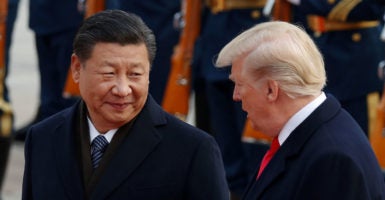President Donald Trump’s visit to Asia has now taken him to the People’s Republic of China, where Chinese leader Xi Jinping staged an elaborate welcome, complete with a personally guided private visit to the famous Forbidden City.
Observers have expected that two of the main concerns to be discussed by Trump and Xi would be North Korea and U.S.-China trade. China is North Korea’s primary supporter, and Trump has repeatedly criticized China for the scale of the trade deficit, as well as for unfair trading practices.
Trump and Xi reportedly had extended discussions on the North Korea issue, but it remains to be seen what new measures, if any, China will actually impose. The two leaders merely agreed that stability on the peninsula was of interest to both countries, with Xi promising to enforce current United Nations sanctions.
Even less clear is how long such efforts will remain in place. Beijing has a habit of publicly announcing various sanctions on Pyongyang, only to quietly stop enforcing them weeks or months later.
On trade, Trump accused the Chinese of conducting one-sided and unfair trading practices, but then indicated that this was as much the fault of past American leaders—who essentially let China get away with such practices—as it was Beijing, which took “advantage of another country for the benefit of its citizens.”
He did say, however, that “we really have to look at access, forced technology transfer, and the theft of intellectual property, which just by and of itself is costing the United States and its government at least $300 billion a year.”
As in Korea and Japan, Trump reiterated that the U.S. would have to change its trade policies, but did not say what those changes would be.
The Chinese president, meanwhile, was gracious yet unyielding. It is clear that Beijing sought to impress Trump with a lavish welcome. As the opening to the 2008 Olympics demonstrated, few nations can stage a spectacle like the Chinese.
But it is not clear that Beijing is prepared to change its actual policies. Whether Xi and Trump reached any agreements on intellectual property rights protection, sustained improvement in access to Chinese markets, or subsidies to state-owned enterprises remains uncertain.
In this regard, the announcement of some $250 billion in trade deals gave Trump the appearance of winning but, again, how much substance is there remains to be seen (e.g., How many of these deals had been negotiated long in advance, and how many were “nonbinding”?).
With U.S. allies Japan and South Korea, the most important message Trump needed to send was the fundamental stability of America’s commitment. Although trade issues will arise and economic differences may irritate, Trump needed to signal that the underlying core of continued American support and mutual security would remain firm.
From most accounts, this was achieved in Seoul and Tokyo.
With China, the president needed to underscore that these commitments to our allies are not subject to a Chinese veto. And just as important, he needed to make clear that although the two nations share certain interests, including stabilizing the Korean Peninsula and preserving the broader international economic system, there are also major differences that separate the two: freedom of the seas, including the South China Sea; adherence to the rules, whether economic or cyber; and respect for human rights.
The next several weeks and months should tell us whether he sent those messages—and whether Beijing received them.





























